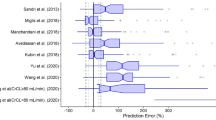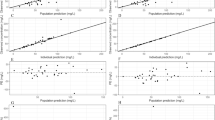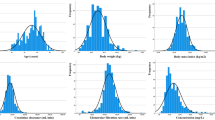Abstract
Background and objective
External evaluation is an important issue in the population pharmacokinetic analysis of antibiotics. The purpose of this review was to summarize the current approaches and status of external evaluations and discuss the implications of external evaluation results for the future individualization of dosing regimens.
Methods
We systematically searched the PubMed and EMBASE databases for external evaluation studies of population analysis and extracted the relevant information from these articles. A total of 32 studies were included in this review.
Results
Vancomycin was investigated in 17 (53.1%) articles and was the most studied drug. Other studied drugs included gentamicin, tobramycin, amikacin, amoxicillin, ceftaroline, meropenem, fluconazole, voriconazole, and rifampicin. Nine (28.1%) studies were prospective, and the sample size varied widely between studies. Thirteen (40.6%) studies evaluated the population pharmacokinetic models by systematically searching for previous studies. Seven (21.9%) studies were multicenter studies, and 27 (84.4%) adopted the sparse sampling strategy. Almost all external evaluation studies of antibiotics (93.8%) used metrics for prediction-based diagnostics, while relatively fewer studies were based on simulations (46.9%) and Bayesian forecasting (25.0%).
Conclusion
The results of external evaluations in previous studies revealed the poor extrapolation performance of existing models of prediction- and simulation-based diagnostics, whereas the posterior Bayesian method could improve predictive performance. There is an urgent need for the development of standards and guidelines for external evaluation studies.




Similar content being viewed by others
References
Vincent J-L, Rello J, Marshall J, et al. International study of the prevalence and outcomes of infection in intensive care units. JAMA. 2009;302(21):2323–9. https://doi.org/10.1001/jama.2009.1754.
Roberts JA, Abdul-Aziz MH, Lipman J, et al. Individualised antibiotic dosing for patients who are critically ill: challenges and potential solutions. Lancet Infect Dis. 2014;14(6):498–509. https://doi.org/10.1016/s1473-3099(14)70036-2.
Mouton JW, Ambrose PG, Canton R, et al. Conserving antibiotics for the future: new ways to use old and new drugs from a pharmacokinetic and pharmacodynamic perspective. Drug Resist Updates. 2011;14(2):107–17. https://doi.org/10.1016/j.drup.2011.02.005.
Darwich AS, Ogungbenro K, Vinks AA, et al. Why has model-informed precision dosing not yet become common clinical reality? lessons from the past and a roadmap for the future. Clin Pharmacol Ther. 2017;101(5):646–56. https://doi.org/10.1002/cpt.659.
Hartmanshenn C, Scherholz M, Androulakis IP. Physiologically-based pharmacokinetic models: approaches for enabling personalized medicine. J Pharmacokinet Pharmacodyn. 2016;43(5):481–504. https://doi.org/10.1007/s10928-016-9492-y.
Calvo E, Walko C, Dees EC, et al. Pharmacogenomics, pharmacokinetics, and pharmacodynamics in the era of targeted therapies. Am Soc Clin Oncol Educ Book. 2016;35:e175–84. https://doi.org/10.1200/edbk_159061.
Neely M, Philippe M, Rushing T, et al. Accurately achieving target busulfan exposure in children and adolescents with very limited sampling and the BestDose software. Ther Drug Monit. 2016;38(3):332–42. https://doi.org/10.1097/ftd.0000000000000276.
Kantasiripitak W, Van Daele R, Gijsen M, et al. Software tools for model-informed precision dosing: how well do they satisfy the needs? Front Pharmacol. 2020;11:620. https://doi.org/10.3389/fphar.2020.00620.
Wicha SG, Kees MG, Solms A, et al. TDMx: a novel web-based open-access support tool for optimising antimicrobial dosing regimens in clinical routine. Int J Antimicrob Agents. 2015;45(4):442–4. https://doi.org/10.1016/j.ijantimicag.2014.12.010.
Gao YC, Jiao Z, Huang H, et al. Development of decision system for individualization of vancomycin dosage (in Chinese). Acta Pharm Sin. 2018;53(1):104–10. https://doi.org/10.16438/j.0513-4870.2017-0673.
Keizer RJ, Ter Heine R, Frymoyer A, et al. Model-informed precision dosing at the bedside: scientific challenges and opportunities. CPT Pharmacometrics Syst Pharmacol. 2018;7(12):785–7. https://doi.org/10.1002/psp4.12353.
Sun H, Fadiran EO, Jones CD, et al. Population pharmacokinetics: a regulatory perspective. Clin Pharmacokinet. 1999;37(1):41–58. https://doi.org/10.2165/00003088-199937010-00003.
Ette EI, Williams PJ. Population pharmacokinetics II: estimation methods. Ann Pharmacother. 2004;38(11):1907–15. https://doi.org/10.1345/aph.1E259.
Sheiner LB, Ludden TM. Population pharmacokinetics/dynamics. Annu Rev Pharmacol Toxicol. 1992;32:185–209. https://doi.org/10.1146/annurev.pa.32.040192.001153.
de Velde F, Mouton JW, de Winter BCM, et al. Clinical applications of population pharmacokinetic models of antibiotics: challenges and perspectives. Pharmacol Res. 2018;134:280–8. https://doi.org/10.1016/j.phrs.2018.07.005.
Wang CH, Liu Y, Zhao SX, et al. Systematic research of vancomycin population pharmacokinetic models (in Chinese). Chin J Clin Pharmacol. 2020;36(3):354–6. https://doi.org/10.13699/j.cnki.1001-6821,2020.03.037.
US FDA. Population pharmacokinetics: guidance for industry (draft guidance). 2019. https://www.fda.gov/media/128793/download. Accessed Jul 2019.
Brendel K, Dartois C, Comets E, et al. Are population pharmacokinetic and/or pharmacodynamic models adequately evaluated? A survey of the literature from 2002 to 2004. Clin Pharmacokinet. 2007;46(3):221–34. https://doi.org/10.2165/00003088-200746030-00003.
Moher D, Shamseer L, Clarke M, et al. Preferred reporting items for systematic review and meta-analysis protocols (PRISMA-P) 2015 statement. Syst Rev. 2015;4(1):1. https://doi.org/10.1186/2046-4053-4-1.
Jamsen KM, McLeay SC, Barras MA, et al. Reporting a population pharmacokinetic-pharmacodynamic study: a journal’s perspective. Clin Pharmacokinet. 2014;53(2):111–22. https://doi.org/10.1007/s40262-013-0114-1.
Kanji S, Hayes M, Ling A, et al. Reporting guidelines for clinical pharmacokinetic studies: the ClinPK statement. Clin Pharmacokinet. 2015;54(7):783–95. https://doi.org/10.1007/s40262-015-0236-8.
Moons KGM, Kengne AP, Grobbee DE, et al. Risk prediction models: II. External validation, model updating, and impact assessment. Heart. 2012;98(9):691–8. https://doi.org/10.1136/heartjnl-2011-301247.
Zhang R, Chen M, Liu TT, et al. Comparison of the predictive performance between cystatin C and serum creatinine by vancomycin via a population pharmacokinetic models: a prospective study in a Chinese population. Eur J Drug Metab Pharmacokinet. 2020;45(1):135–49. https://doi.org/10.1007/s13318-019-00578-4.
Šíma M, Bakhouche H, Hartinger J, et al. Therapeutic drug monitoring of antibiotic agents: evaluation of predictive performance. Eur J Hosp Pharm. 2019;26(2):85–8. https://doi.org/10.1136/ejhpharm-2017-001396.
Guo T, van Hest RM, Roggeveen LF, et al. External evaluation of population pharmacokinetic models of vancomycin in large cohorts of intensive care unit patients. Antimicrob Agents Chemother. 2019;63(5):e02543-18. https://doi.org/10.1128/AAC.02543-18.
Broeker A, Nardecchia M, Klinker KP, et al. Towards precision dosing of vancomycin: a systematic evaluation of pharmacometric models for Bayesian forecasting. Clin Microbiol Infect. 2019;25(10):1286.e1–7. https://doi.org/10.1016/j.cmi.2019.02.029.
Kimura H, Shigematsu M, Tanaka A, et al. Predictive performance of vancomycin trough concentrations in patients with diabetes with microalbuminuria. Ther Drug Monit. 2017;39(6):614–6. https://doi.org/10.1097/ftd.0000000000000454.
Medellin-Garibay SE, Ortiz-Martin B, Rueda-Naharro A, et al. Pharmacokinetics of vancomycin and dosing recommendations for trauma patients. J Antimicrob Chemother. 2016;71(2):471–9. https://doi.org/10.1093/jac/dkv372.
Taghizadeh-Ghehi M, Rezaee S, Gholami K, et al. Predictive performance of Vancomycin population pharmacokinetic models in Iranian patients underwent hematopoietic stem cell transplantation. J Res Pharm Pract. 2015;4(3):129–34. https://doi.org/10.4103/2279-042X.162357.
Stockmann C, Hersh AL, Roberts JK, et al. Predictive performance of a vancomycin population pharmacokinetic model in neonates. Infect Dis Ther. 2015;4(2):187–98. https://doi.org/10.1007/s40121-015-0067-9.
Hahn A, Frenck RW Jr, Zou Y, et al. Validation of a pediatric population pharmacokinetic model for vancomycin. Ther Drug Monit. 2015;37(3):413–6. https://doi.org/10.1097/ftd.0000000000000153.
Ng TM, Lye DC, Chan M, et al. Predictive performance of pharmacokinetic models for outpatients receiving vancomycin continuous infusion. Int J Antimicrob Agents. 2014;43(2):197–9. https://doi.org/10.1016/j.ijantimicag.2013.10.007.
Zhao W, Kaguelidou F, Biran V, et al. External evaluation of population pharmacokinetic models of vancomycin in neonates: the transferability of published models to different clinical settings. Br J Clin Pharmacol. 2013;75(4):1068–80. https://doi.org/10.1111/j.1365-2125.2012.04406.x.
Deng C, Liu T, Wu K, et al. Predictive performance of reported population pharmacokinetic models of vancomycin in Chinese adult patients. J Clin Pharm Ther. 2013;38(6):480–9. https://doi.org/10.1111/jcpt.12092.
Marsot A, Vialet R, Boulamery A, et al. Vancomycin: predictive performance of a population pharmacokinetic model and optimal dose in neonates and young infants. Clin Pharmacol Drug Dev. 2012;1(4):144–51. https://doi.org/10.1177/2160763X12456843.
Sanchez JL, Dominguez AR, Lane JR, et al. Population pharmacokinetics of vancomycin in adult and geriatric patients: comparison of eleven approaches. Int J Clin Pharmacol Ther. 2010;48(8):525–33. https://doi.org/10.5414/cpp48525.
Rushing TA, Ambrose PJ. Clinical application and evaluation of vancomycin dosing in adults. J Pharm Technol. 2001;17(2):33–8. https://doi.org/10.1177/875512250101700201.
Beringer PM, Wong-Beringer A, Rho JP. Predictive performance of a vancomycin-aminoglycoside population model. Ann Pharmacother. 1998;32(2):176–81. https://doi.org/10.1345/aph.17129.
Fernandez de Gatta MM, Fruns I, Dominguez-Gil A. Individualizing vancomycin dosing regimens: an evaluation of two pharmacokinetic dosing programs in critically ill patients. Pharmacotherapy. 1994;14(2):196–201.
Ge S, Beechinor RJ, Hornik CP, et al. External evaluation of a gentamicin infant population pharmacokinetic model using data from a mational electronic health record database. Antimicrob Agents Chemother. 2018;62(9):e00669-18. https://doi.org/10.1128/aac.00669-18.
Bukkems LH, Roger C, Hodiamont CJ, et al. Predictive performance of a gentamicin population pharmacokinetic model in two western populations of critically ill patients. Int J Antimicrob Agents. 2018;52(2):218–25. https://doi.org/10.1016/j.ijantimicag.2018.04.016.
Llanos-Paez CC, Staatz CE, Lawson R, et al. A population pharmacokinetic model of gentamicin in pediatric oncology patients to facilitate personalized dosing. Antimicrob Agents Chemother. 2017;61(8):e00205–17. https://doi.org/10.1128/aac.00205-17.
Sampson MR, Frymoyer A, Rattray B, et al. Predictive performance of a gentamicin population pharmacokinetic model in neonates receiving full-body hypothermia. Ther Drug Monit. 2014;36(5):584–9. https://doi.org/10.1097/ftd.0000000000000056.
Alghanem S, Paterson I, Touw DJ, et al. Influence of multiple courses of therapy on aminoglycoside clearance in adult patients with cystic fibrosis. J Antimicrob Chemother. 2013;68(6):1338–47. https://doi.org/10.1093/jac/dkt035.
Wolowich WR, Steinberg JG. External validation of aminoglycoside models used in web calculators and clinical decision support systems after laboratory conversion to serum creatinine isotope dilution mass spectrometry assay. Clin Ther. 2012;34(4):803–10. https://doi.org/10.1016/j.clinthera.2012.02.005.
Burgard M, Sandaradura I, van Hal SJ, et al. Evaluation of tobramycin exposure predictions in three Bayesian forecasting programmes compared with current clinical practice in children and adults with cystic fibrosis. Clin Pharmacokinet. 2018;57(8):1017–27. https://doi.org/10.1007/s40262-017-0610-9.
Bloomfield C, Staatz CE, Unwin S, et al. Assessing predictive performance of published population pharmacokinetic models of intravenous tobramycin in pediatric patients. Antimicrob Agents Chemother. 2016;60(6):3407–14. https://doi.org/10.1128/aac.02654-15.
Gauthier T, Lacarelle B, Marre F, et al. Predictive performance of two software packages (USC*PACK PC and Abbott PKS system) for the individualization of amikacin dosage in intensive care unit patients. Int J Biomed Comput. 1994;36(1–2):131–4. https://doi.org/10.1016/0020-7101(94)90104-x.
Tang BH, Wu YE, Kou C, et al. Population pharmacokinetics and dosing optimization of amoxicillin in neonates and young infants. Antimicrob Agents Chemother. 2019;63(2):e02336-18. https://doi.org/10.1128/AAC.02336-18.
Van Wart SA, Forrest A, Khariton T, et al. Population pharmacokinetics of ceftaroline in patients with acute bacterial skin and skin structure infections or community-acquired bacterial pneumonia. J Clin Pharmacol. 2013;53(11):1155–67. https://doi.org/10.1002/jcph.153.
Dhaese SAM, Farkas A, Colin P, et al. Population pharmacokinetics and evaluation of the predictive performance of pharmacokinetic models in critically ill patients receiving continuous infusion meropenem: a comparison of eight pharmacokinetic models. J Antimicrob Chemother. 2019;74(2):432–41. https://doi.org/10.1093/jac/dky434.
Hwang MF, Beechinor RJ, Wade KC, et al. External evaluation of two fluconazole infant population pharmacokinetic models. Antimicrob Agents Chemother. 2017;61(12):e01352-17. https://doi.org/10.1128/aac.01352-17.
Farkas A, Daroczi G, Villasurda P, et al. Comparative evaluation of the predictive performances of three different structural population pharmacokinetic models to predict future voriconazole concentrations. Antimicrob Agents Chemother. 2016;60(11):6806–12. https://doi.org/10.1128/aac.00970-16.
van Beek SW, ter Heine R, Keizer RJ, et al. Personalized tuberculosis treatment through model-informed dosing of rifampicin. Clin Pharmacokinet. 2019;58(6):815–26. https://doi.org/10.1007/s40262-018-00732-2.
Karlsson MO, Savic RM. Diagnosing model diagnostics. Clin Pharmacol Ther. 2007;82(1):17–20. https://doi.org/10.1038/sj.clpt.6100241.
Sheiner LB, Beal SL. Some suggestions for measuring predictive performance. J Pharmacokinet Biopharm. 1981;9(4):503–12. https://doi.org/10.1007/bf01060893.
Zhao CY, Jiao Z, Mao JJ, et al. External evaluation of published population pharmacokinetic models of tacrolimus in adult renal transplant recipients. Br J Clin Pharmacol. 2016;81(5):891–907. https://doi.org/10.1111/bcp.12830.
Hennig S, Holthouse F, Staatz CE. Comparing dosage adjustment methods for once-daily tobramycin in paediatric and adolescent patients with cystic fibrosis. Clin Pharmacokinet. 2015;54(4):409–21. https://doi.org/10.1007/s40262-014-0211-9.
Mould DR, D’Haens G, Upton RN. Clinical decision support tools: the evolution of a revolution. Clin Pharmacol Ther. 2016;99(4):405–18. https://doi.org/10.1002/cpt.334.
Purwonugroho TA, Chulavatnatol S, Preechagoon Y, et al. Population pharmacokinetics of vancomycin in Thai patients. ScientificWorldJournal. 2012;2012:762649. https://doi.org/10.1100/2012/762649.
Bleeker SE, Moll HA, Steyerberg EW, et al. External validation is necessary in prediction research: a clinical example. J Clin Epidemiol. 2003;56(9):826–32. https://doi.org/10.1016/s0895-4356(03)00207-5.
Aljutayli A, Marsot A, Nekka F. An update on population pharmacokinetic analyses of vancomycin, part I: in adults. Clin Pharmacokinet. 2020;59(6):671–98. https://doi.org/10.1007/s40262-020-00866-2.
Standing JF. Understanding and applying pharmacometric modelling and simulation in clinical practice and research. Br J Clin Pharmacol. 2017;83(2):247–54. https://doi.org/10.1111/bcp.13119.
Duffull SB, Wright DF. What do we learn from repeated population analyses? Br J Clin Pharmacol. 2015;79(1):40–7. https://doi.org/10.1111/bcp.12233.
Aarons L, Ogungbenro K. Optimal design of pharmacokinetic studies. Basic Clin Pharmacol Toxicol. 2010;106(3):250–5. https://doi.org/10.1111/j.1742-7843.2009.00533.x.
Vergouwe Y, Steyerberg EW, Eijkemans MJC, et al. Substantial effective sample sizes were required for external validation studies of predictive logistic regression models. J Clin Epidemiol. 2005;58(5):475–83. https://doi.org/10.1016/j.jclinepi.2004.06.017.
Steyerberg EW, Borsboom GJJM, van Houwelingen HC, et al. Validation and updating of predictive logistic regression models: a study on sample size and shrinkage. Stat Med. 2004;23(16):2567–86. https://doi.org/10.1002/sim.1844.
Sheiner LB. NONMEM users guides: parts I–VII. NONMEM Project Group. San Francisco (CA): University of California, San Francisco; 1992.
Prémaud A, Weber LT, Tönshoff B, et al. Population pharmacokinetics of mycophenolic acid in pediatric renal transplant patients using parametric and nonparametric approaches. Pharmacol Res. 2011;63(3):216–24. https://doi.org/10.1016/j.phrs.2010.10.017.
Altman DG, Royston P. What do we mean by validating a prognostic model? Stat Med. 2000;19(4):453–73. https://doi.org/10.1002/(sici)1097-0258(20000229)19:4%3c453:aid-sim350%3e3.0.co;2-5.
Lamarre P, Lebel D, Ducharme MP. A population pharmacokinetic model for vancomycin in pediatric patients and its predictive value in a naive population. Antimicrob Agents Chemother. 2000;44(2):278–82. https://doi.org/10.1128/aac.44.2.278-282.2000.
Piana C, Danhof M, Della Pasqua O. Influence of covariate distribution on the predictive performance of pharmacokinetic models in paediatric research. Br J Clin Pharmacol. 2014;78(1):145–57. https://doi.org/10.1111/bcp.12322.
Donagher J, Barras MA. Therapeutic drug monitoring: using Bayesian methods to evaluate hospital practice. J Pharm Pract Res. 2018;48(6):522–9. https://doi.org/10.1002/jppr.1432.
Mao JJ, Jiao Z, Yun HY, et al. External evaluation of population pharmacokinetic models for ciclosporin in adult renal transplant recipients. Br J Clin Pharmacol. 2018;84(1):153–71. https://doi.org/10.1111/bcp.13431.
Cai X, Li R, Sheng C, et al. Systematic external evaluation of published population pharmacokinetic models for tacrolimus in adult liver transplant recipients. Eur J Pharm Sci. 2020;145:105237. https://doi.org/10.1016/j.ejps.2020.105237.
Donagher J, Martin JH, Barras MA. Individualised medicine: why we need Bayesian dosing. Intern Med J. 2017;47(5):593–600. https://doi.org/10.1111/imj.13412.
Tsamandouras N, Rostami-Hodjegan A, Aarons L. Combining the ‘bottom up’ and ‘top down’ approaches in pharmacokinetic modelling: fitting PBPK models to observed clinical data. Br J Clin Pharmacol. 2015;79(1):48–55. https://doi.org/10.1111/bcp.12234.
Upreti VV, Venkatakrishnan K. Model-based meta-analysis: optimizing research, development, and utilization of therapeutics using the totality of evidence. Clin Pharmacol Ther. 2019;106(5):981–92. https://doi.org/10.1002/cpt.1462.
Espié P, Tytgat D, Sargentini-Maier M-L, et al. Physiologically based pharmacokinetics (PBPK). Drug Metab Rev. 2009;41(3):391–407. https://doi.org/10.1080/10837450902891360.
Author information
Authors and Affiliations
Corresponding authors
Ethics declarations
Funding
This work was supported by the Fujian Science and Technology Innovation Joint Project (no. 2017Y9036) and Wu Jieping Medical Foundation (no. 320.6750.2020-04-47).
Conflict of interest
Yu Cheng, Chen-yu Wang, Zi-ran Li, Yan Pan, Mao-bai Liu, and Zheng Jiao have no conflicts of interest that are directly relevant to the content of this study.
Ethics approval
Not applicable.
Consent to participate
Not applicable.
Consent for publication
Not applicable.
Availability of data and material
All data generated or analysed during this study are included in this published article (and its supplementary information files).
Code availability
Not applicable.
Author Contributions
YC carried out the literature search and wrote the first draft of the manuscript; CW, ZL, and YP developed the search strategy and reviewed the articles; ZJ conceptualized the study; ML and ZJ supervised the study and reviewed the entire contents of the manuscript. All authors have read and agree to the published version of the manuscript.
Electronic supplementary material
Below is the link to the electronic supplementary material.
Rights and permissions
About this article
Cite this article
Cheng, Y., Wang, Cy., Li, Zr. et al. Can Population Pharmacokinetics of Antibiotics be Extrapolated? Implications of External Evaluations. Clin Pharmacokinet 60, 53–68 (2021). https://doi.org/10.1007/s40262-020-00937-4
Published:
Issue Date:
DOI: https://doi.org/10.1007/s40262-020-00937-4




